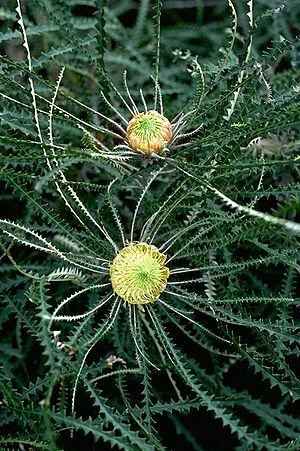Swordfish dryandra facts for kids
The Swordfish dryandra (Banksia mucronulata) is a special type of shrub. It is found only in Western Australia. This plant gets its common name because its leaves look a bit like a swordfish's snout!
The Swordfish dryandra has spreading, hairy stems. Its leaves are long and deeply cut with sharp, pointy edges. It produces pale yellow or cream-colored flowers. These flowers grow in groups of 80 to 180. After flowering, it forms egg-shaped seed pods called follicles.
Quick facts for kids Swordfish dryandra |
|
|---|---|
 |
|
| Scientific classification | |
| Genus: |
Banksia
|
| Species: |
mucronulata
|
| Synonyms | |
|
|
What Does It Look Like?
The Swordfish dryandra is a shrub that usually grows from about 0.5 to 2.5 meters tall. It does not have a special woody base called a lignotuber. This means it cannot regrow from underground if the top part is destroyed, for example, by fire.
Its stems are hairy and spread out. The leaves are long, about 15 to 25 centimeters in length. They are also narrow, measuring 0.4 to 1.2 centimeters wide. The underside of the leaves has short, woolly hairs.
Each leaf has many sharp, pointy lobes, usually between forty and sixty on each side. The flowers are pale yellow or cream-colored. They grow in round groups, or "heads," with 80 to 180 flowers in each.
At the base of each flower head are hairy, oblong bracts. These are like small leaves that protect the flowers. They are about 2 to 2.5 centimeters long.
The flower parts (called the perianth) are 1.8 to 3 centimeters long. The female part of the flower (the pistil) is 2.3 to 3 centimeters long and curved. This plant flowers from May to July. After flowering, it produces egg-shaped, hairy seed pods called follicles. These pods are 1.4 to 2 centimeters long.
How It Got Its Name
This plant was first officially described in 1810. A botanist named Robert Brown gave it the name Dryandra mucronulata. He published his description in a scientific journal called Transactions of the Linnean Society of London.
The second part of its scientific name, mucronulata, comes from a Latin word. It means "having a small point." This refers to the tiny, sharp points on the tips of the leaf lobes.
Later, in 2007, two other scientists, Austin Mast and Kevin Thiele, made a change. They moved all plants from the Dryandra group into the Banksia group. So, this plant was renamed Banksia mucronulata, which is its current scientific name.
Where It Lives
The Swordfish dryandra grows in specific types of natural areas. It can be found in kwongan, which is a type of shrubland. It also lives in general shrubland areas. Sometimes, it grows in wandoo woodland, which is a forest with a type of eucalyptus tree called wandoo.
You can find this plant in Western Australia. It grows in the area between the towns of Cranbrook and Cheyne Beach. This includes parts of the Stirling Range, a mountain range known for its unique plants.
Is It Safe?
The good news is that the Swordfish dryandra is not considered to be in danger. The Western Australian Government's Department of Parks and Wildlife has classified it as "not threatened." This means there are enough of these plants in the wild for now.

